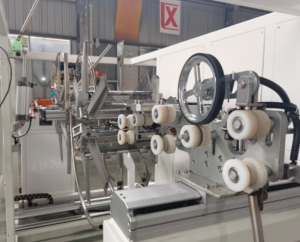Mastering Hose Packaging: The Power of Automatic Coil Winding and Strapping Machines
Efficiently managing and packaging lengthy materials like hoses, pipes, or cables presents a significant challenge in many industrial settings. Manual coiling and strapping are often time-consuming, labor-intensive, and can lead to inconsistencies in package quality. Enter the automatic coil winding and strapping machine – a sophisticated piece of packaging equipment designed to streamline this process entirely. This guide explores how these machines operate, their key benefits, and essential considerations.
Video demonstrating an automatic coil winding and strapping operation.
An automatic coil winding and strapping machine, particularly designs focusing on horizontal applications, automates the entire sequence from receiving the hose to outputting a securely strapped coil, ready for storage or shipment.
How it Works: The Automated Process Explained

Understanding the operational flow highlights the efficiency gains offered by these machines:
- Material Infeed: The hose or pipe is typically fed into the machine, often via a connected extruder line or a separate payoff stand. Sensors detect the material's presence and initiate the cycle.
- Precise Coiling: The material is guided to the coiling station. A winding mechanism, often involving rotating arms or a specialized coiling head, forms the material into a neat, uniform coil of a pre-set diameter and length. Advanced systems ensure consistent tension and layering.
- Coil Transfer: Once the desired length is reached and the material is cut (often automatically), the completed coil is transferred from the coiling station to the strapping station. This is usually achieved through integrated conveyor systems or robotic arms.
- Secure Strapping: At the strapping station, one or more straps (typically Polypropylene (PP) or Polyester (PET)) are automatically applied around the coil's circumference. The machine tensions, seals (usually via heat or friction weld), and cuts the strap, securing the coil tightly. Multiple straps can often be applied at different positions for enhanced stability.
- Discharge: The finished, strapped coil is then automatically ejected from the machine, often onto an exit conveyor or accumulation table, ready for palletizing or further handling.
- Control System Integration: A central Programmable Logic Controller (PLC) governs the entire process. Operators typically interact via a Human-Machine Interface (HMI) to set parameters like coil length, diameter, number of straps, tension, and to monitor the machine's status and diagnostics.
Key Benefits of Automated Winding and Strapping

Integrating an automatic horizontal hose coil winding and strapping machine offers substantial advantages:
- Enhanced Efficiency and Throughput: Automation drastically reduces the time required per coil compared to manual methods, significantly boosting overall production output.
- Improved Consistency and Quality: Machines produce uniform coils with consistent dimensions and strap tension every time, enhancing package appearance and integrity.
- Reduced Labor Costs: By automating repetitive tasks, businesses can reallocate valuable manpower to more complex operations, reducing direct labor costs associated with packaging.
- Enhanced Product Protection: Secure strapping prevents coils from unraveling or becoming damaged during internal handling, storage, and transportation.
- Better Workplace Safety: Automating the coiling and heavy lifting associated with large coils minimizes risks of repetitive strain injuries and accidents related to manual handling.

automatic pipe coiling machine, automatic hose coiling machine9 Core Components and Customization Potential
While designs vary, key components typically include:
- Robust Frame & Conveyors: Provide structural support and manage material/coil movement.
- Coiling Head/Mechanism: The core unit responsible for forming the coil accurately.
- Strapping Unit(s): Dispenses, tensions, seals, and cuts the strapping material. Different heads accommodate various strap types and sizes.
- PLC Control System & HMI: The "brain" of the machine for process control and operator interaction.
- Cutting Mechanism: Automatically cuts the hose/pipe to the required length.
These machines are highly customizable. Manufacturers can tailor them to specific needs, including:
- Coil Dimensions: Handling various inner/outer diameters and coil widths.
- Material Types: Adapting guides and tension controls for different hose/pipe materials (PVC, PE, rubber, PEX, etc.).
- Strapping Specifications: Number of straps, strap positions, type of strap (PP/PET), and tension levels.
- Integration Features: Options for automatic labeling, stretch wrapping integration, or connection to central factory monitoring systems.
Applications Across Industries
While ideal for hose manufacturing, these automated systems are valuable in various sectors:
- Hose & Pipe Extrusion: PVC, PE, PEX, corrugated pipes.
- Cable & Wire: Coiling electrical cables, communication wires, and fiber optics.
- Tubing & Profiles: Packaging various flexible extruded products.
Making the Right Choice
Selecting the appropriate machine involves considering:
- Production Volume: Match machine speed and capacity to output requirements.
- Coil Specifications: Define the range of diameters, widths, and weights needed.
- Material Characteristics: Ensure compatibility with the flexibility, rigidity, and surface of your product.
- Integration Needs: Assess how the machine fits into your existing production line.
- Level of Automation: Determine required features like automatic cutting, labeling, etc.
Conclusion
An automatic horizontal hose coil winding and strapping machine represents a significant step towards optimizing packaging operations. By automating the coiling and securing process, businesses gain substantial improvements in efficiency, consistency, cost-effectiveness, and product protection. For industries handling long lengths of flexible materials, investing in this technology, potentially sourced from specialized providers (as indicated by resources like PMMI - The Association for Packaging and Processing Technologies or similar industry bodies), can yield considerable returns through enhanced productivity and streamlined logistics.
